- Home /
- Resources /
- Learning center /
- Deploy VMware ESXi...
Deploy VMware ESXi on Equinix Metal with Layer2
Learn how to use a VMware ESXi deployment on Equinix Metal in Layer 2 unbonded trunk mode

On this page
- Prerequisites
- Deploy Metal servers using the VMware VCF Operating System Option
- Configure VLANs for Layer 2 Networking
- Connect using the Out-of-Band Console & Configure Networking
- Connect to vCenter and create a new cluster
- Add hosts to the cluster
- Configure distributed networking options
- Conclusion
NOTE: This guide may contain out of date information. In this case, it is preserved and intended only for existing customers with ESXi 6.5/7.
This guide demonstrates how to deploy VMware ESXi on Equinix Metal, using the Layer 2 unbonded trunk mode. This mode enables the allocation of identical VLANs to both the eth0 and eth1 interfaces. You'll use the VMware vSphere Cluster wizard to add servers and configure Distributed Networking specifically for Metal servers.
When provisioning servers with L2 unbonded trunk mode, default IP provisioning is disabled. As a result, you are responsible for self-provisioning IP addresses on server interfaces using the SOS (Self-Service Portal) system.
Prerequisites
- An Equinix Metal Account
- A jumpbox connected to the private VLANs and accessible from the internet
- A VMware account (optional, for installing vCenter/vSphere if this is a new cluster)
- A VMware License (optional, for use beyond the 30-day trial license period)
Deploy Metal servers using the VMware VCF Operating System Option
Begin by deploying an Equinix Metal server through the Metal Portal. Select the desired metro and device type that you'd like to deploy.
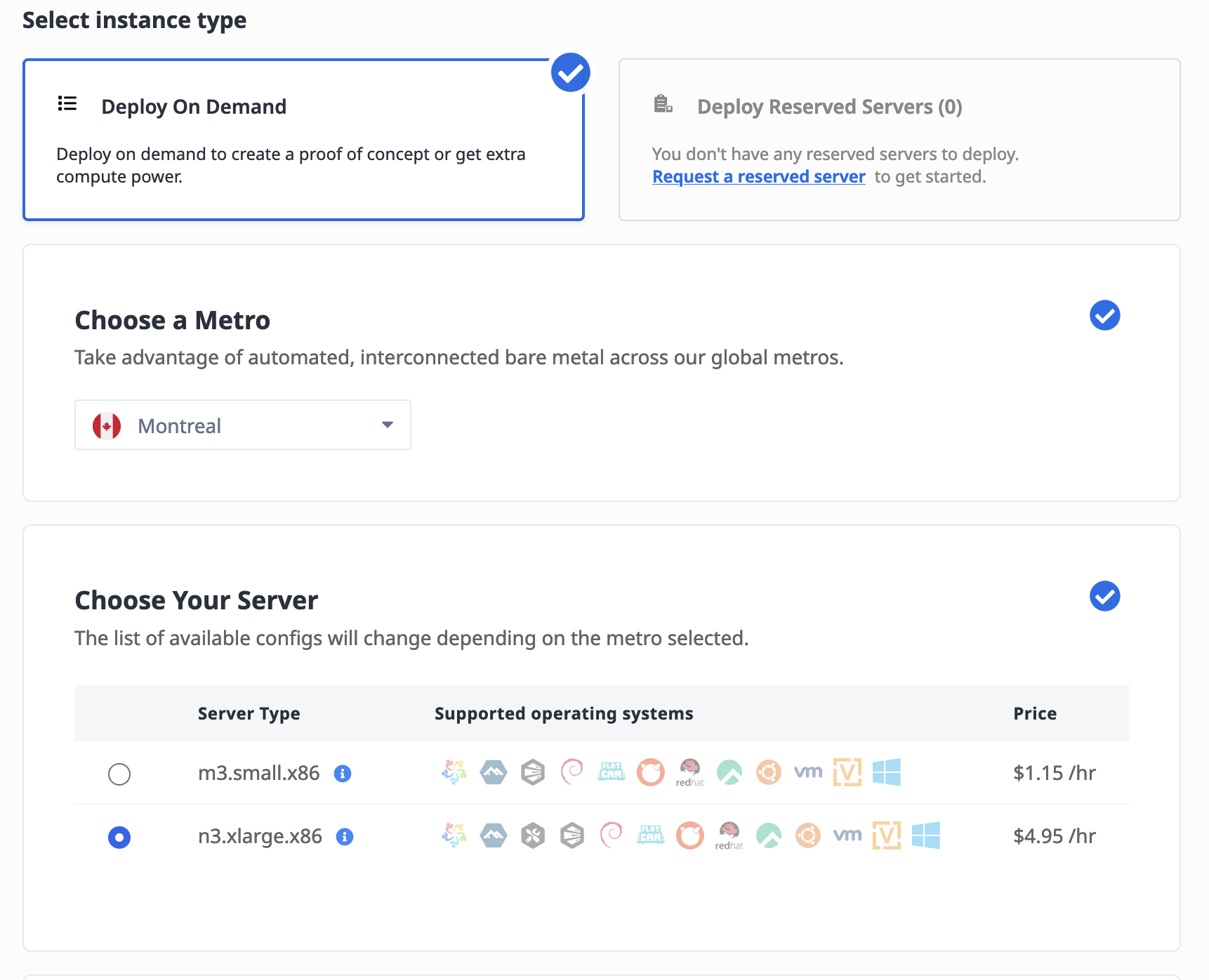
Specify the operating system and the name(s) of how ever many servers you would like to deploy and click Deploy Now to begin provisioning.

When deploying servers in L2 Hypervisor Mode, the deployment of servers does not include any pre-assigned IP addresses since the network interfaces are deployed in Layer 2 Unbonded mode.
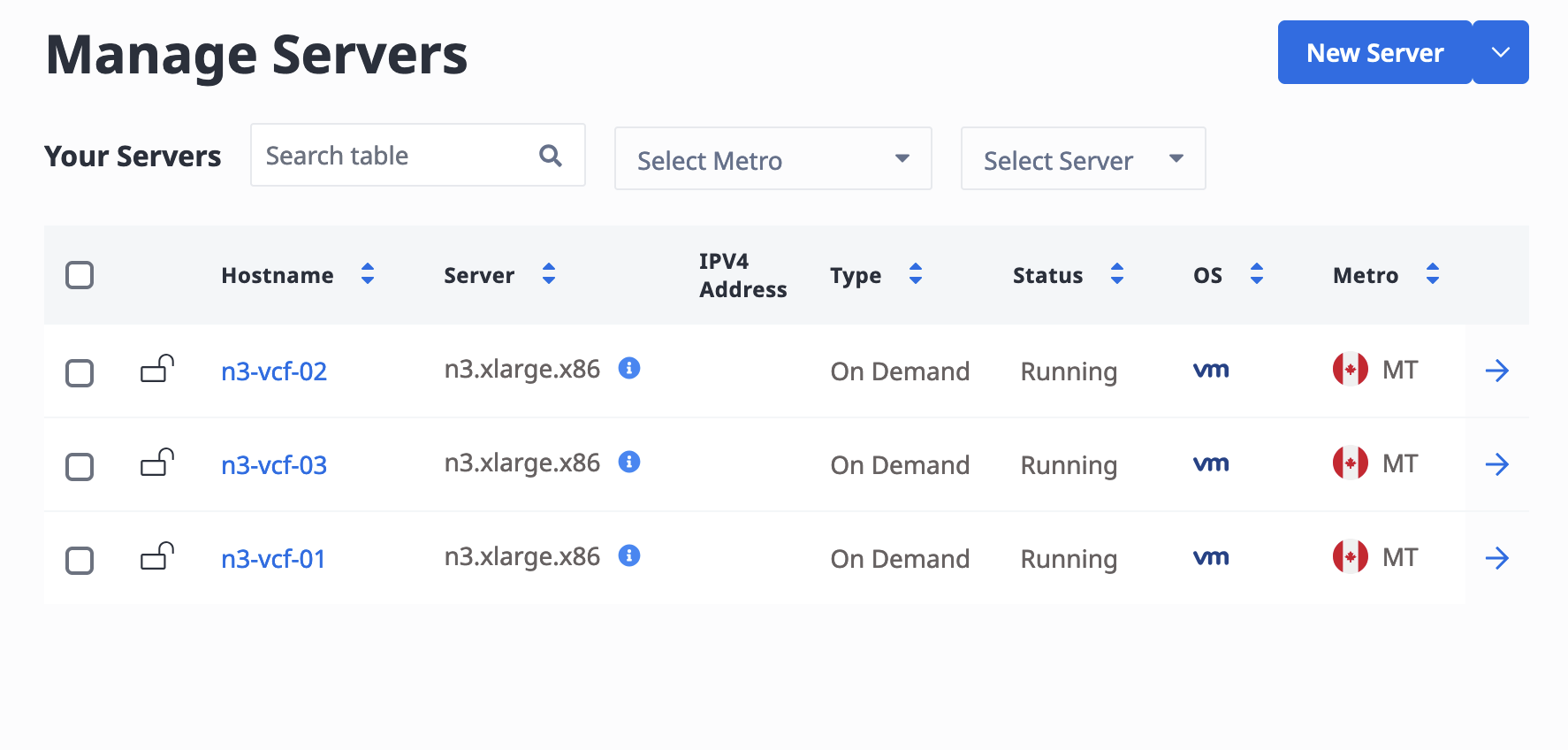
Configure VLANs for Layer 2 Networking
After the servers have been provisioned, you can assign VLANs to their network interfaces. Access the server management page by clicking on the hostname for one of the servers. Then select the Network tab at the top. Under Layer 2, click Attach VLAN:
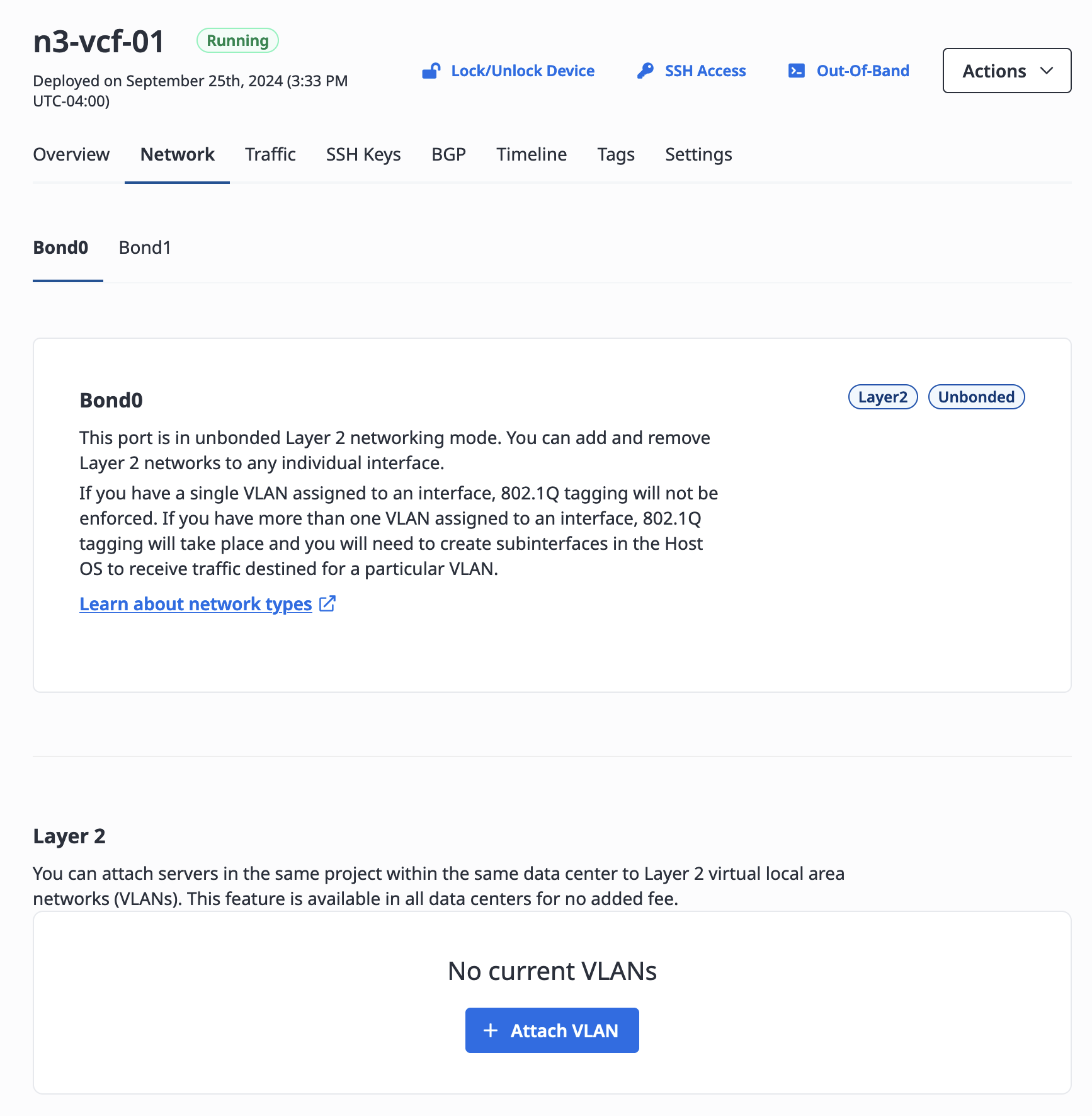
Choose the eth0 interface to add the VLAN. And select the VLAN(s) you'd like to attach to eth0 on the server.
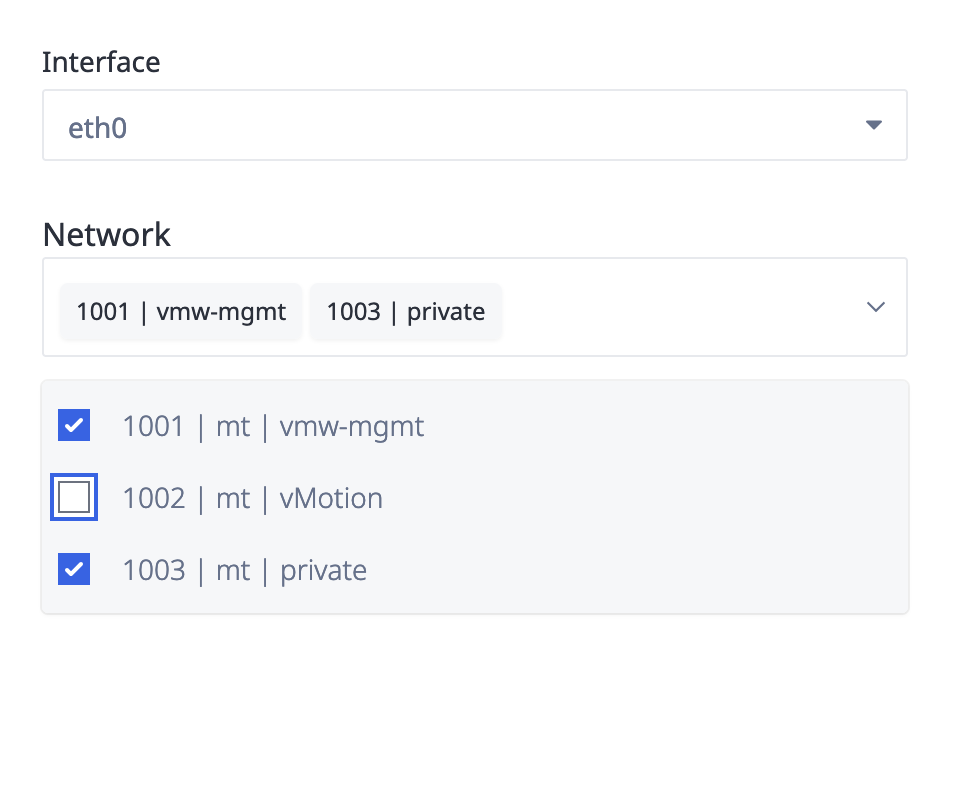
Click the Attach VLAN button on the bottom right to attach the VLANs and after a moment you should be able to verify this in the Layer 2 section of the Network pane.
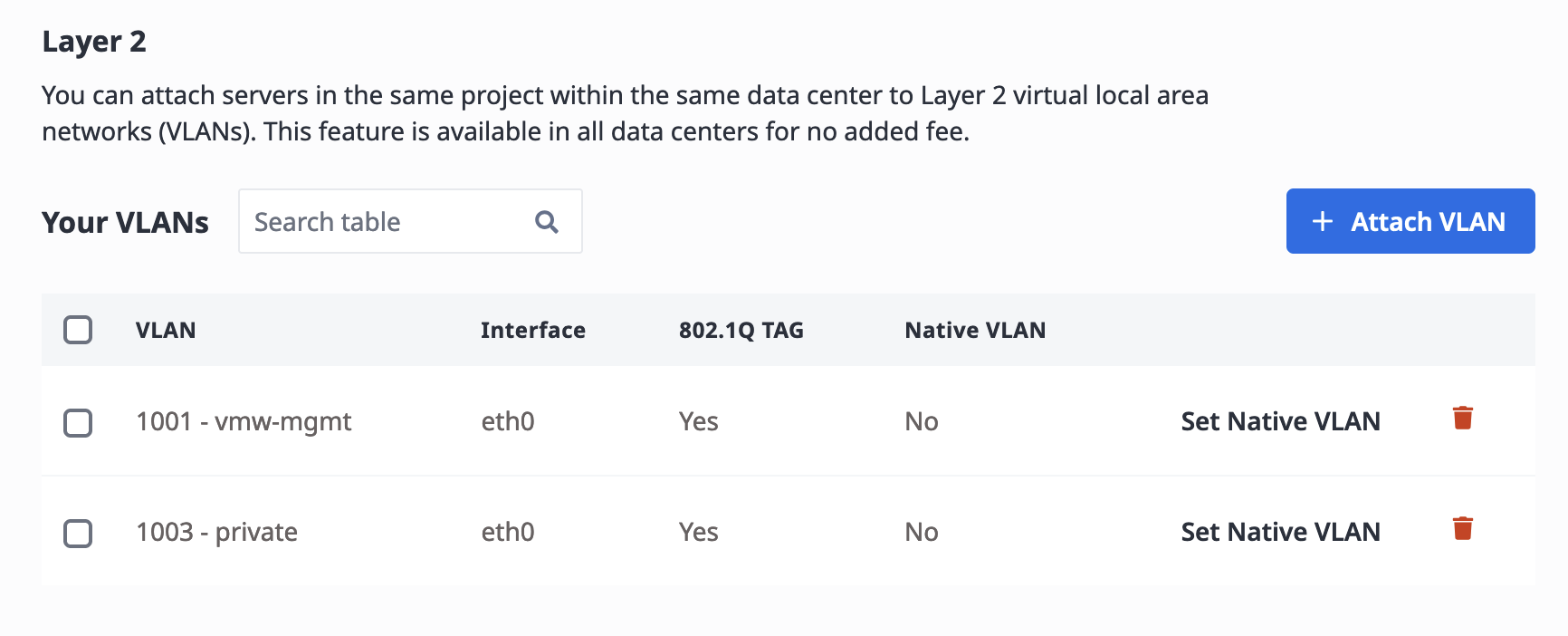
You can repeat this process for any other interfaces youd like attached to any VLANs. In this example, we'll finish attaching all available network interfaces to our management network on our example server:
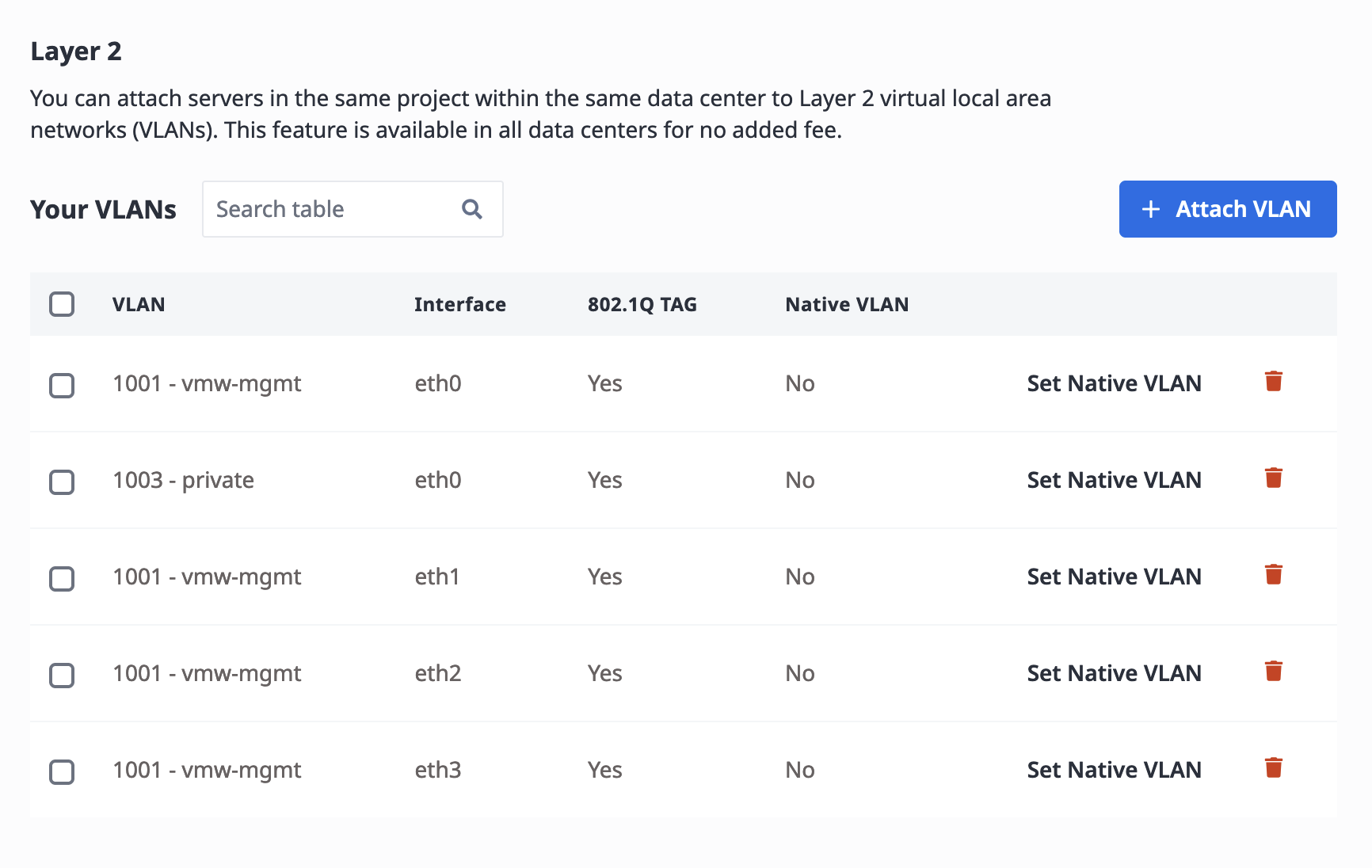
Once done, you'll need to repeat attaching VLANs for the other servers you've deployed.
Connect using the Out-of-Band Console & Configure Networking
Next, we'll connect to the server and assign a custom private Management IP. To access the server's console, click on the terminal icon to the right-side of the server on the main server Manage page, or the Out-Of-Band link at the top-right of the individual server management page and copy the provided SSH command. Make sure to copy the SSH root password and save it in a notepad. The password will no longer be visible on the Metal portal 24 hours after server provisioning.
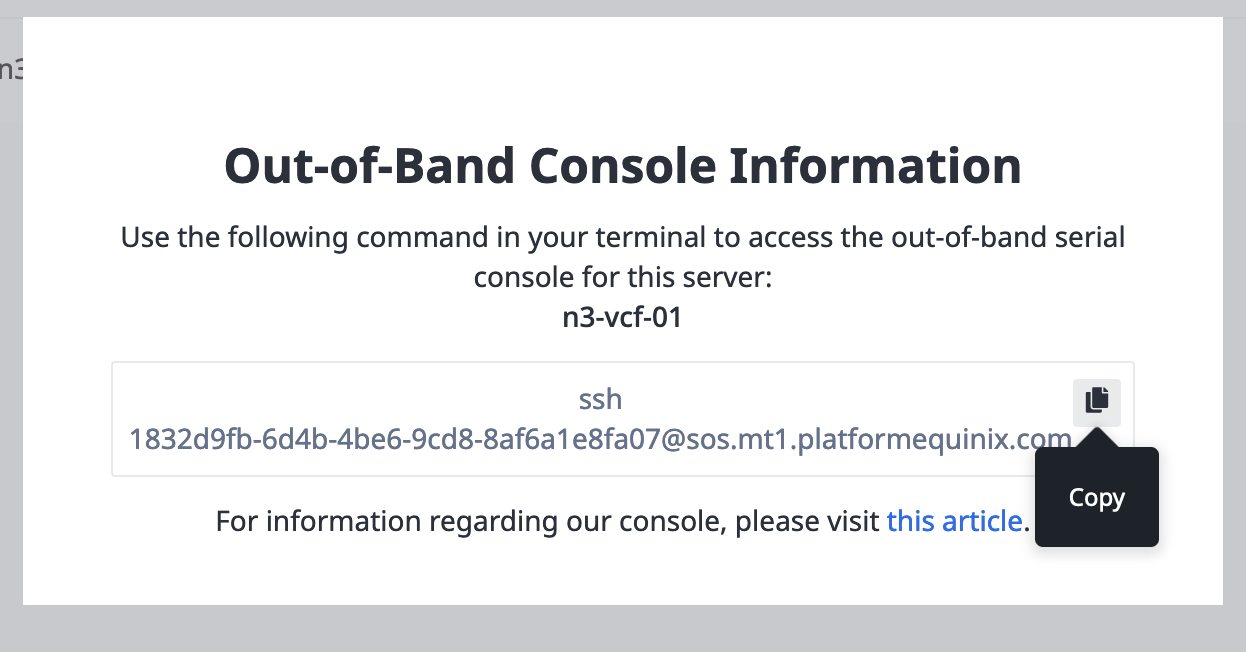
Paste the ssh command in your terminal or use the connection info to connect using your preferred SSH client to connect to the console. As this is Serial over SSH connection, you may need to press a key to get the screen to redraw after connecting.
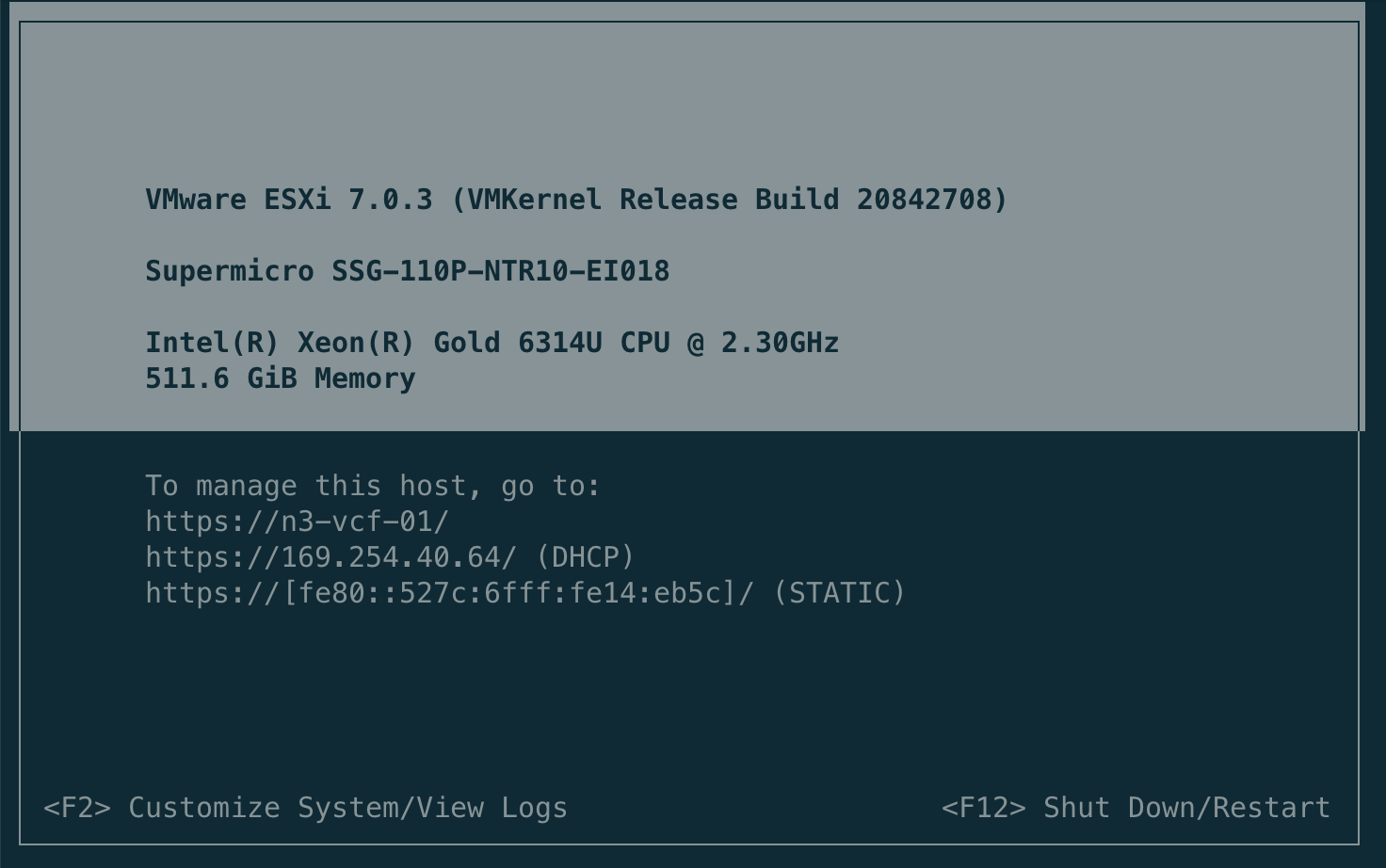
After you connect to the Server Console, press F2 to access the options menu for password rotation and network setup. Enter the password you copied earlier, and then choose the Configure Password option to set a new password.
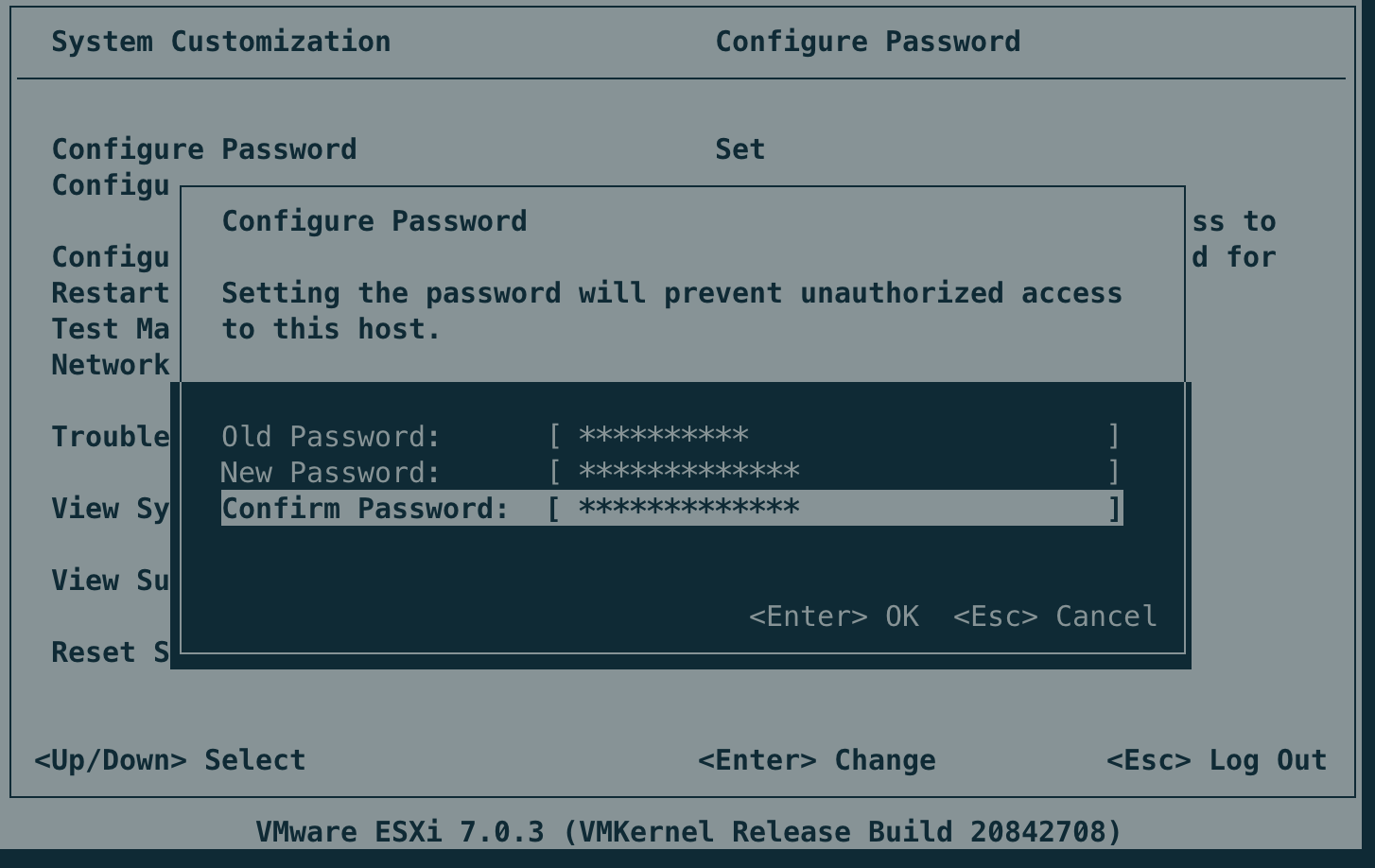
Choose the Configure Management Network option to configure our network adapters for the management network.

Optional: To add redundancy and load-balancing to your management interface, select Network Adapters and enable a second connected adapter. If you haven't already, be sure to enable your management VLAN on that adapter under the Server Management section in the Equinix Metal console.
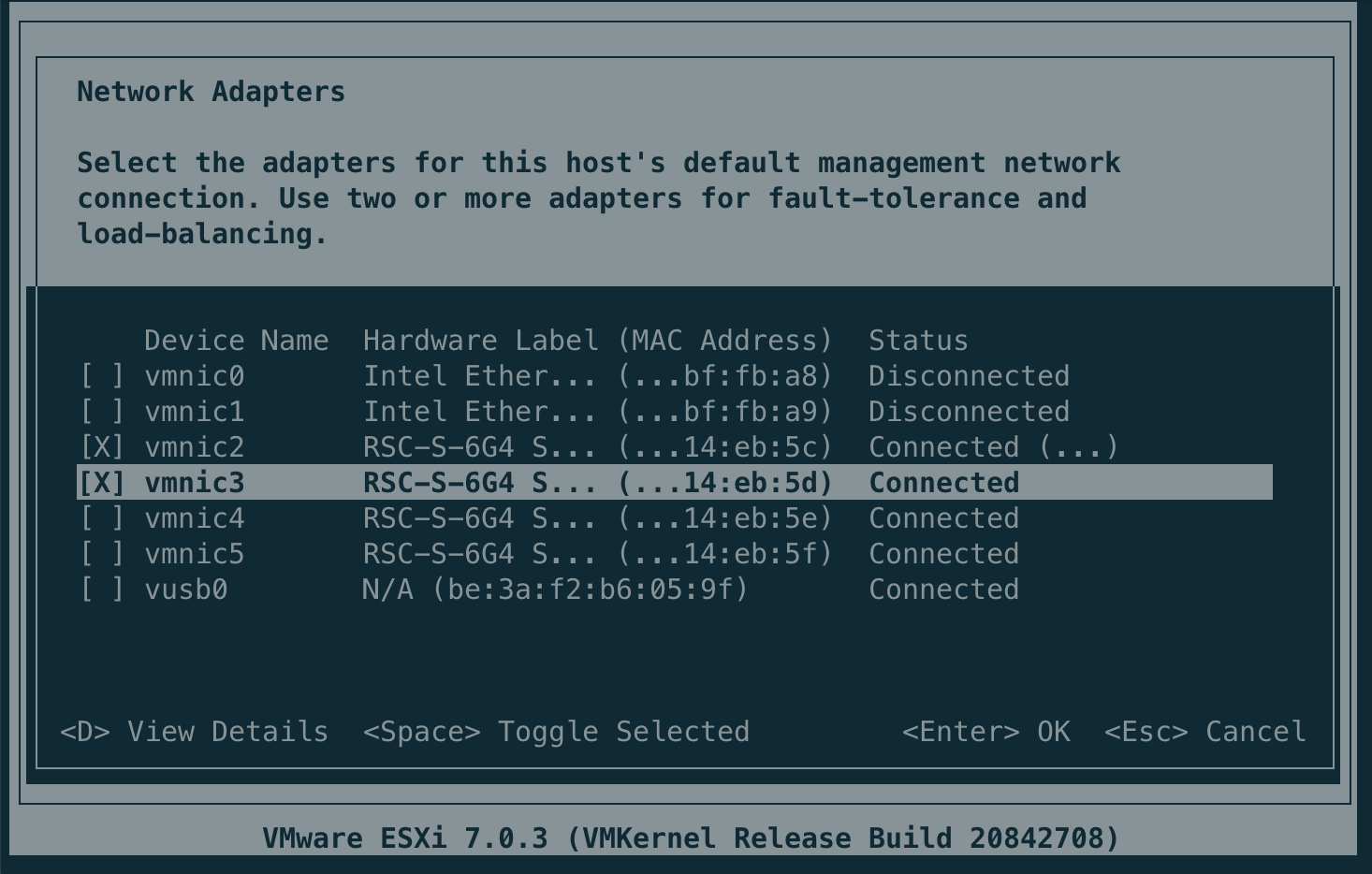
Next, we'll need to enter the VLAN ID for the management network we configured earlier. Select the VLAN menu and enter the ID in the prompt.
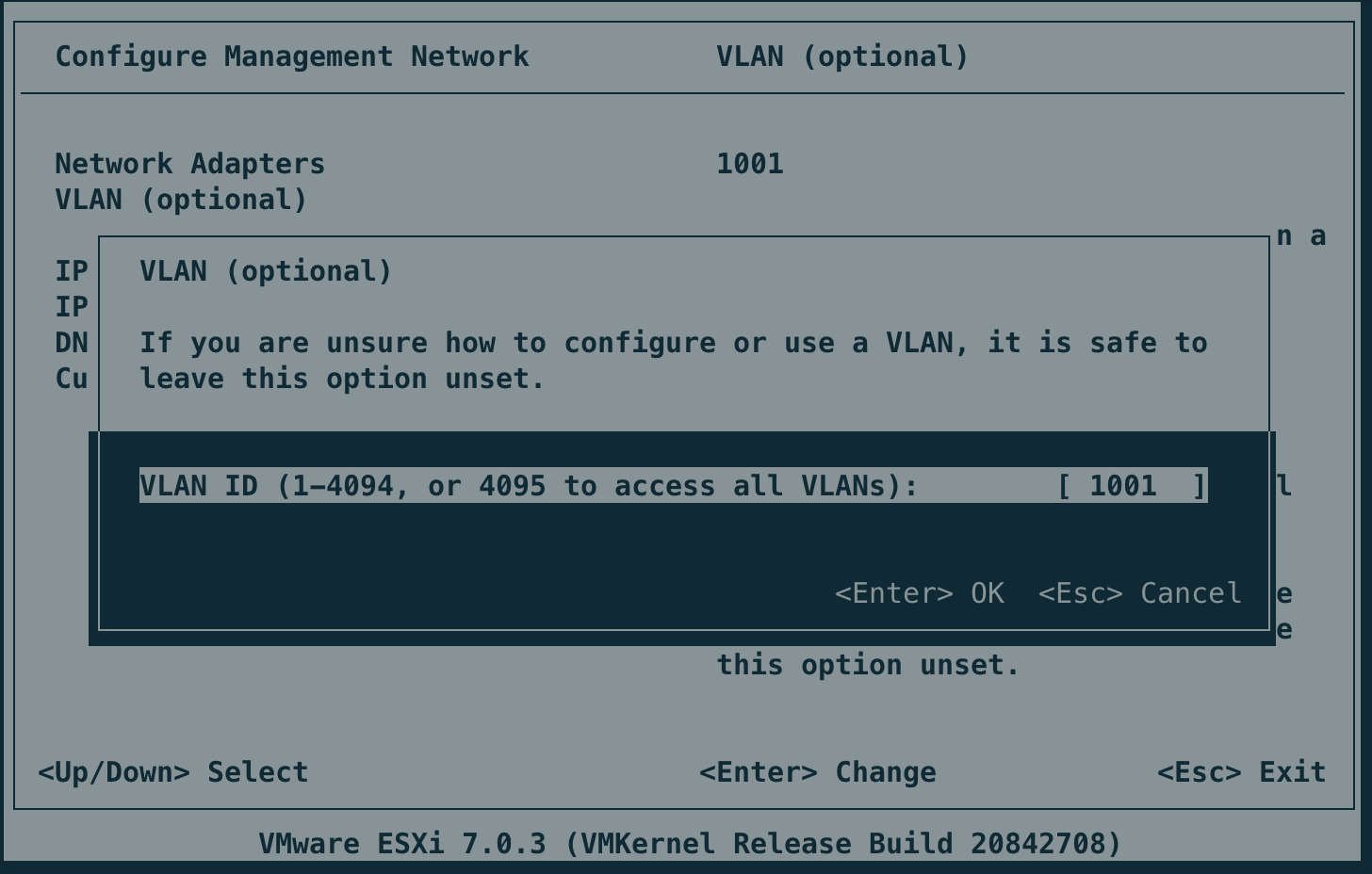
Next, navigate to the IPv4 Configuration menu. Select Set static IPv4 address and network configuration: and assign the IPv4 Address, Subnet Mask, and Default Gateway you're using for the Management network.
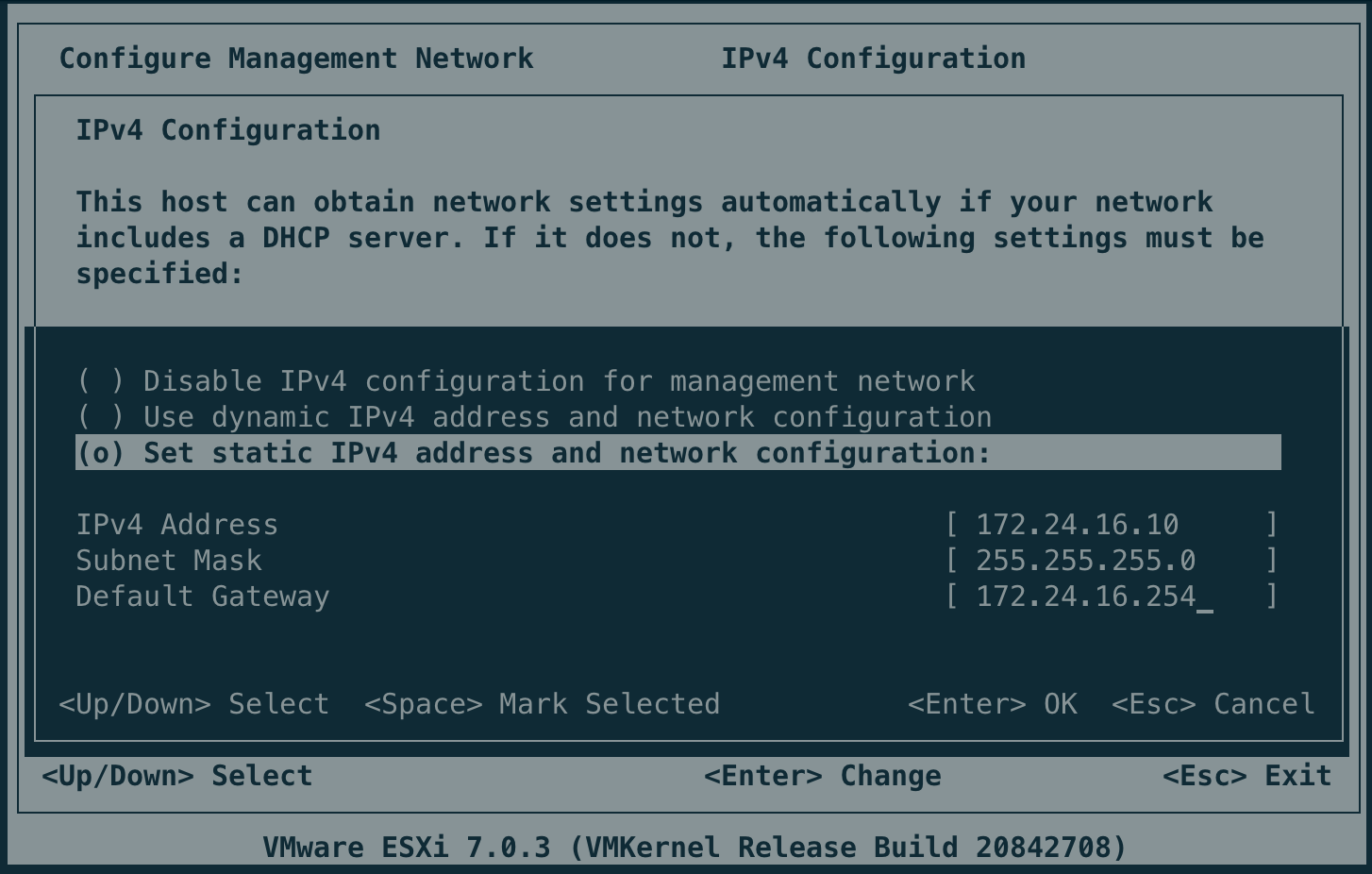
You can also configure the server to use your DNS servers for name resolution. To do this, select DNS Configuration and enter the IP addresses of your DNS servers along with the desired hostname for the server.
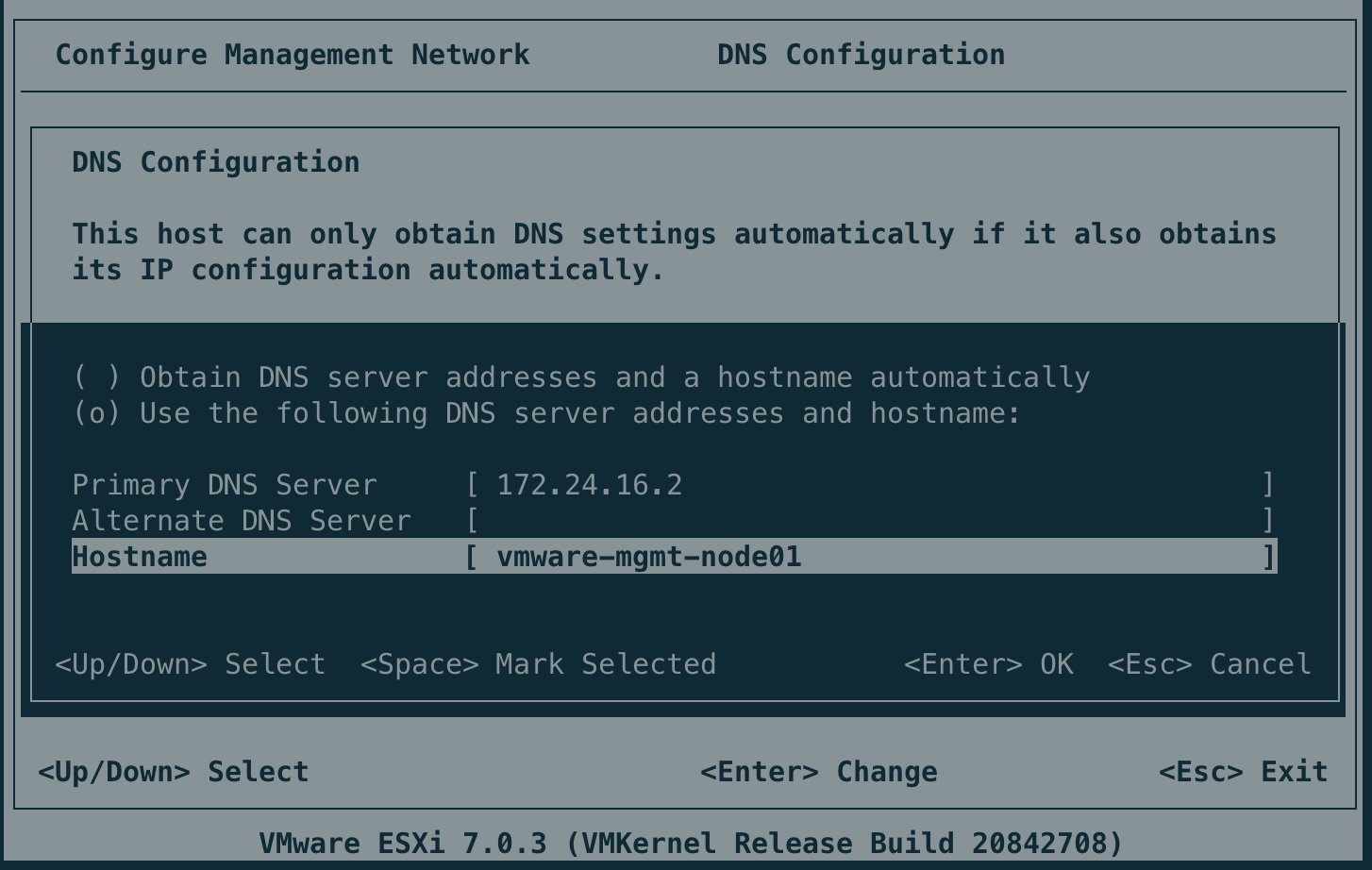
You can conduct a ping test to verify the connection has been established from any system in the same VLAN.

You can now access the ESXi UI from a system on the same VLAN and subnet using the IP address or hostname with DNS resolution.

Connect to vCenter and create a new cluster
The next steps are completed using vCenter. If you haven't already configured this or this is a new cluster, you'll need to follow the VMware documentation to complete that first. Since the servers we've just provisioned have no public internet access, this is the part where you'll need to use a jumpbox with access to the private VLANs. Once that's in place, you'll be able to configure the rest from that jumpbox using the vCenter UI.
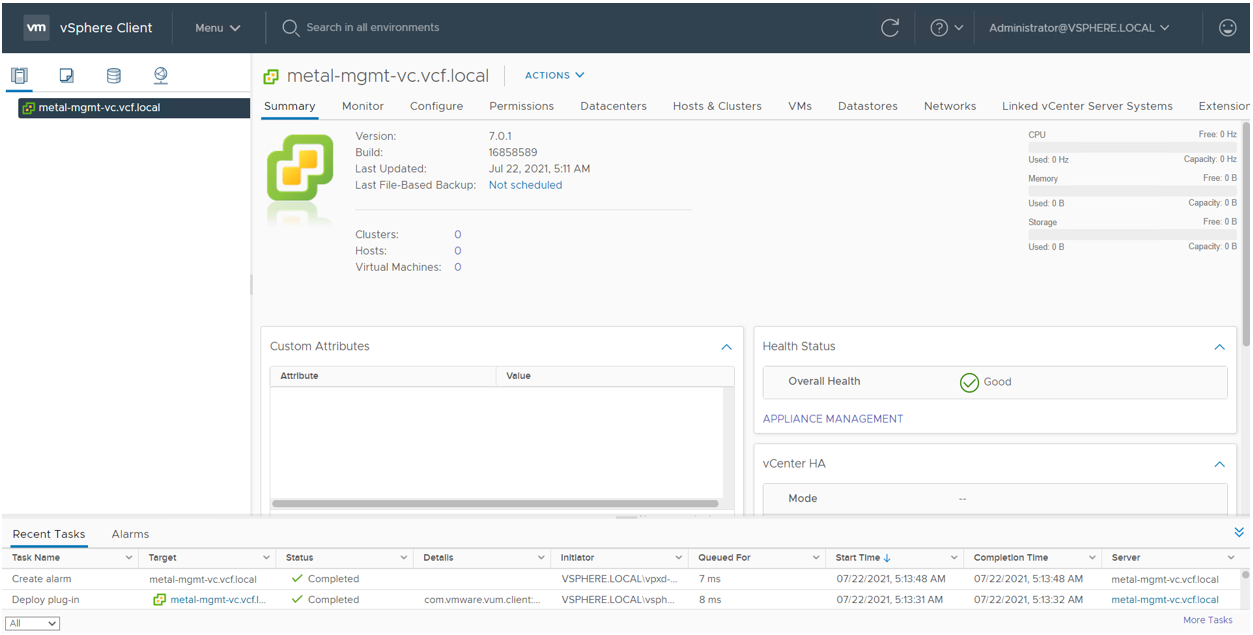
Right-click on the vCenter host and choose New Datacenter to create a new Datacenter object.
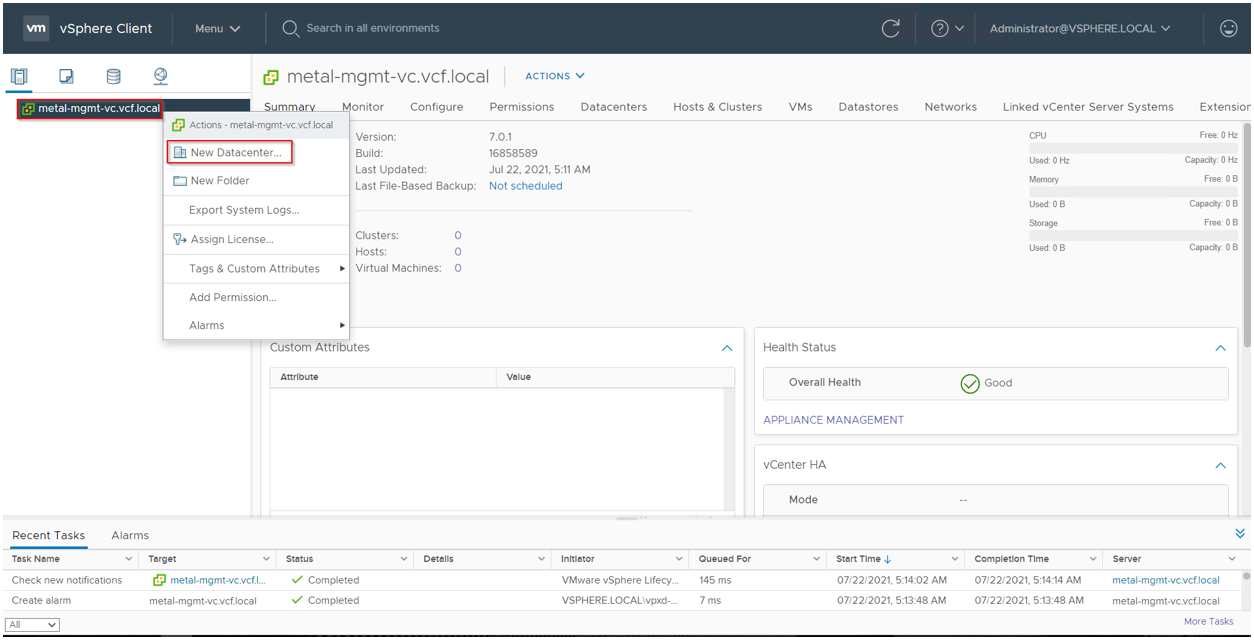
Assign a name to the Datacenter object and click OK.
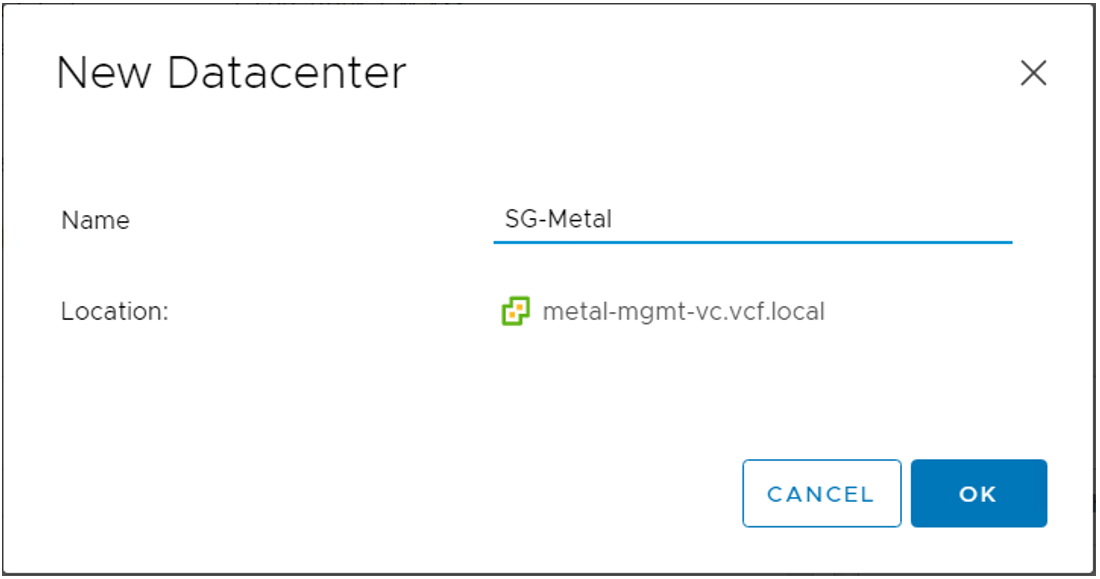
Back on the main navigation, right-click on the datacenter we just created and select New Cluster.
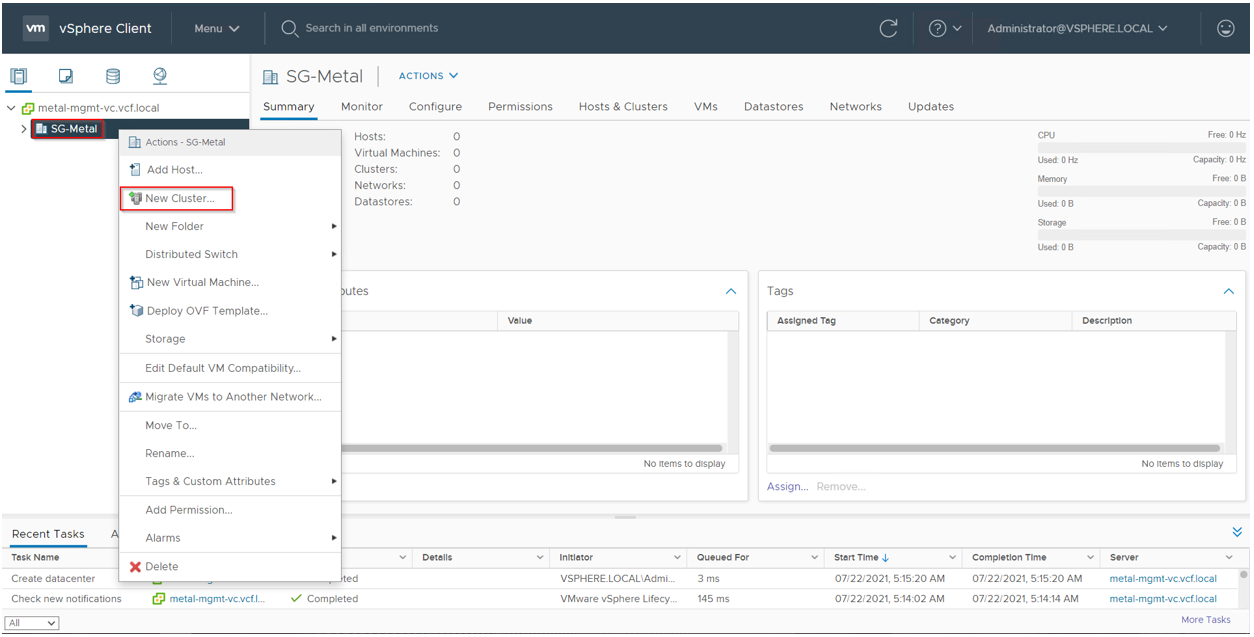
Assign a name to the Cluster and, if desired, enable additional features such as DRS (Distributed Resource Scheduler), HA (High Availability), and/or VSAN (Virtual SAN). Once satisfied with your selections, click OK.

Add hosts to the cluster
After creating the Cluster object, select it from the left-hand navigation, and under the Configure tab, select Quickstart from the Configuration menu.

In the Add Hosts section, click the Add button.

Fill in the new hostnames and credentials for all hosts as needed
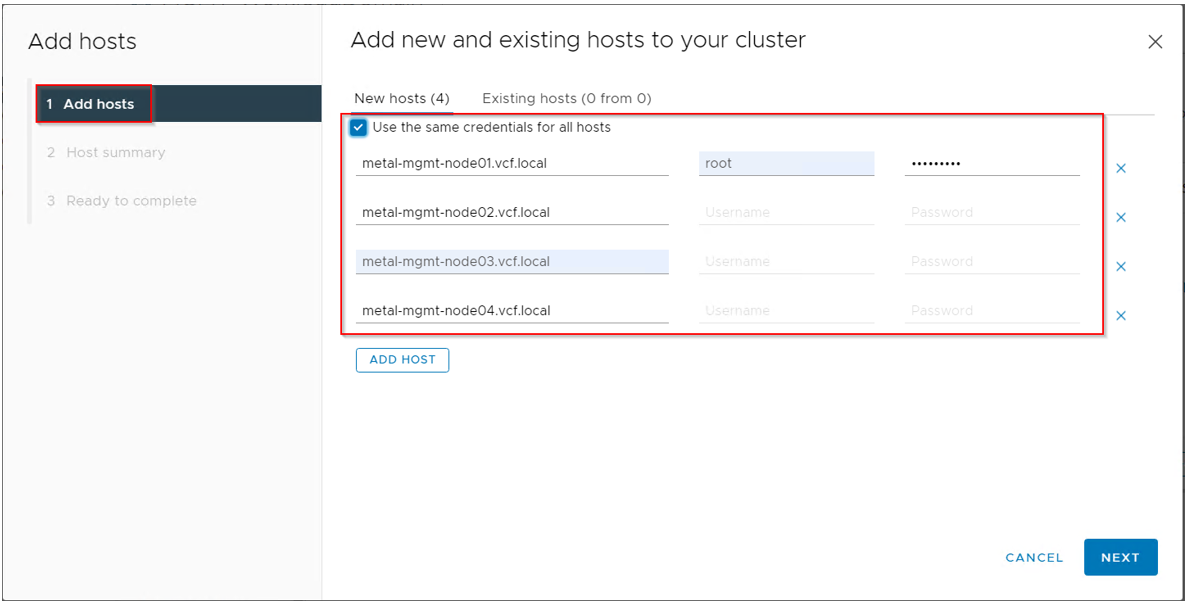
If you haven't configured a central certificate authority, you'll need to accept the self-signed certificates by selecting their SHA1 signatures and clicking OK.

After creating the Cluster object, select it from the left-hand navigation, and under the Configure tab, select Quickstart from the Configuration menu.
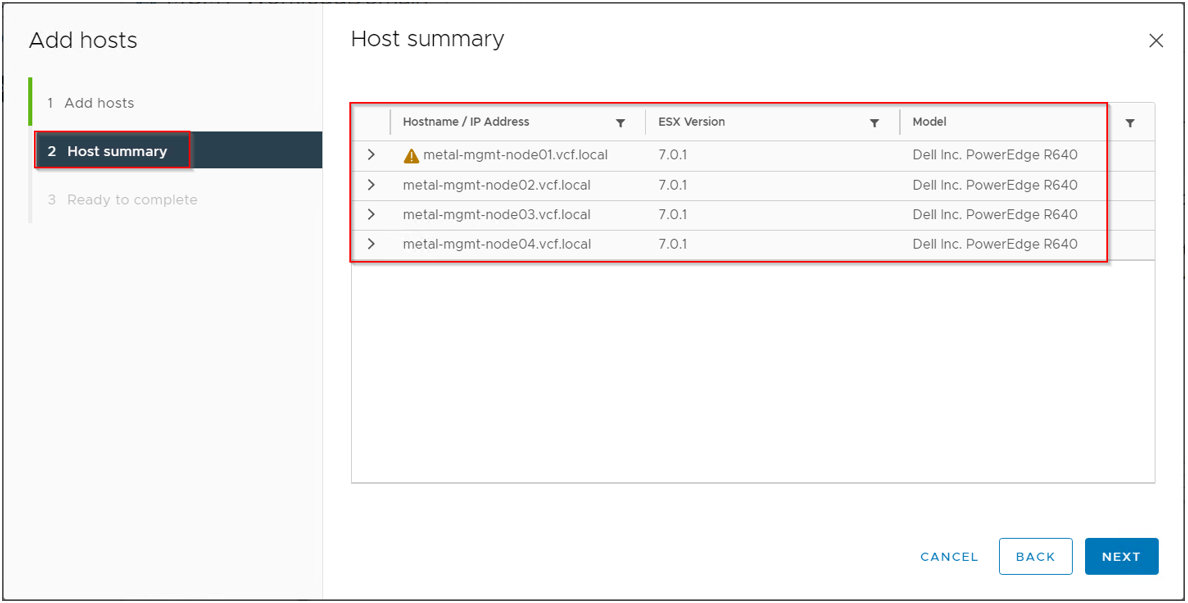
You'll be presented with a review of the actions to be taken. Click Finish to move the hosts into your cluster.
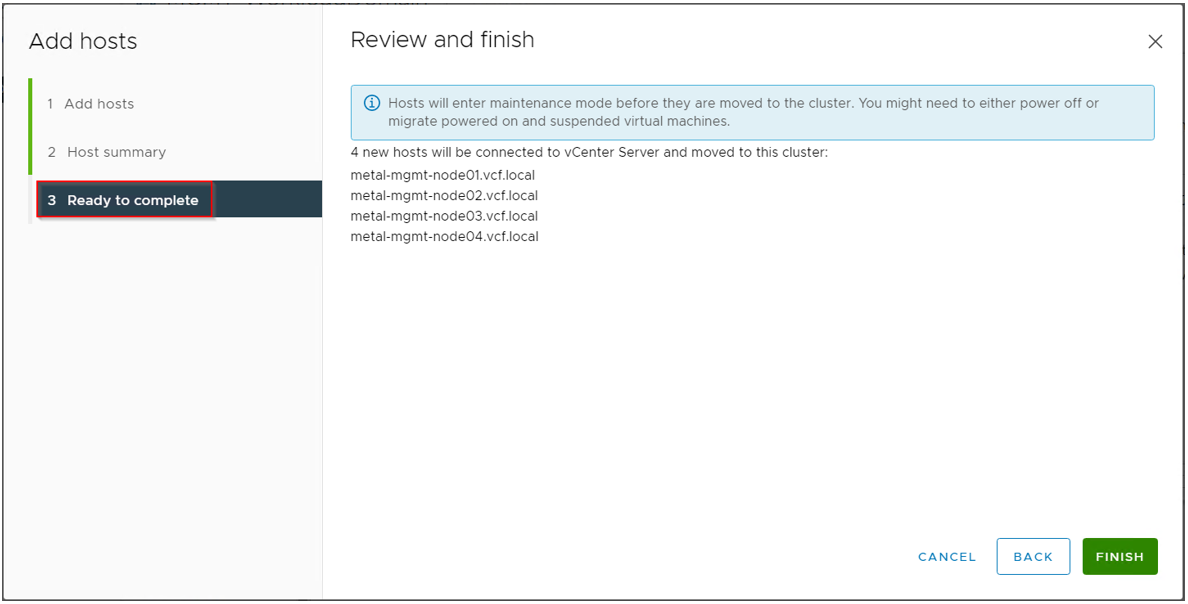
Once all the hosts have been successfully added to the Cluster, the hosts without any workloads will remain in Maintenance Mode as shown.
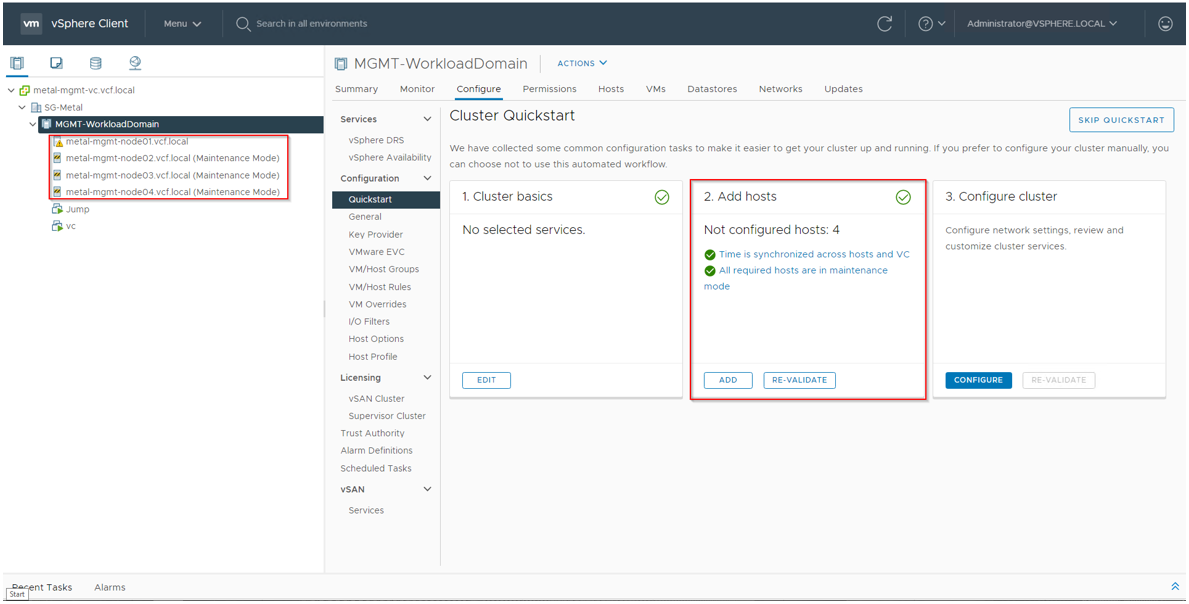
Configure distributed networking options
Now we'll configure network settings and add Virtual Distributed Switches. From the Quickstart menu, click on the Configure button under the Configure Cluster heading.
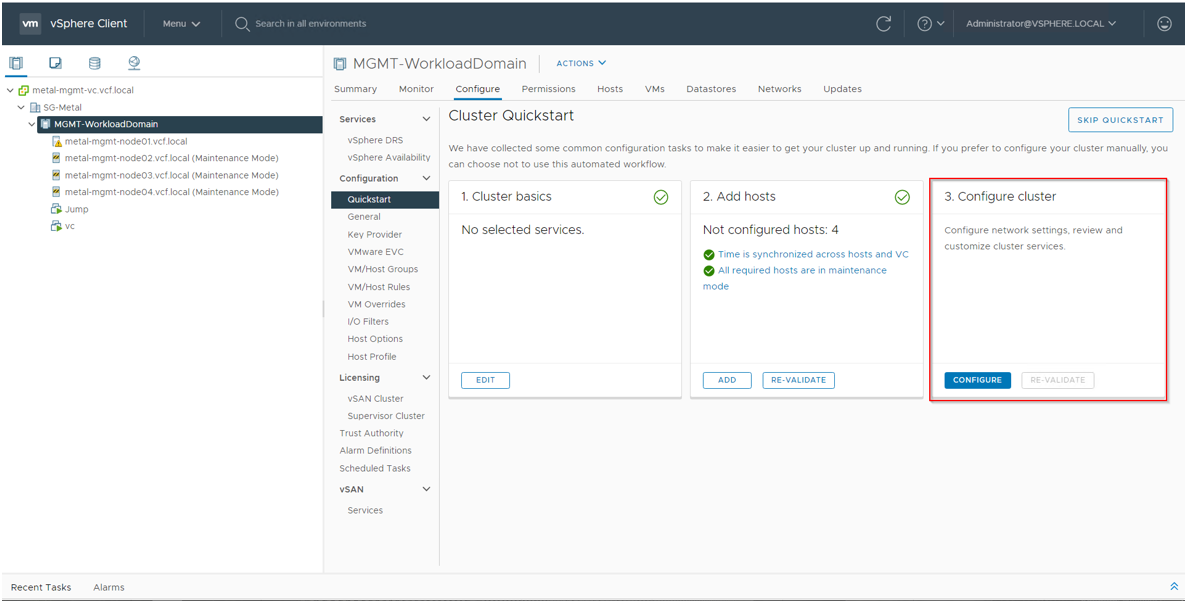
Configure distributed switches by specifying the desired number of switches, assigning names to them, and selecting the number of uplinks.
NOTE: Only vCenter (VCSA) should be powered on and active on the hosts before configuring the Cluster Network settings through the Cluster QuickStart wizard. Any other VM workloads should be powered off during this process.
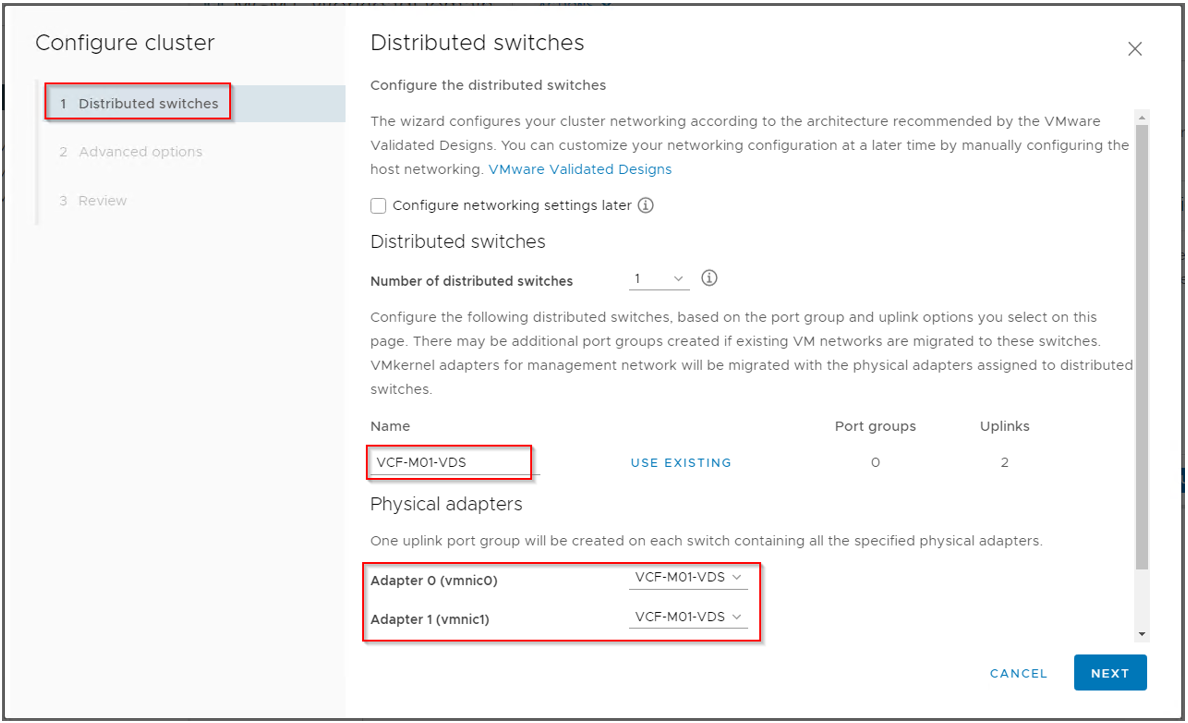
Next, input any advanced options, like an NTP server for synchronization, and click Next.

Review the configuration details and click Finish.

The Cluster QuickStart wizard configures the distributed network switches and migrates the VM workload to the new vDS (Virtual Distributed Switch) port groups.
In vCenter, you'll see the new distributed switch and port groups created and the ESXi hosts attached to that. You can see your network topology by selecting the new distributed switch from the networking menus, then clicking Configure and Topology as shown.

Here is an example of a Management port group within the vDS (Virtual Distributed Switch), displaying the assigned VLANs and the configured Teaming policy.
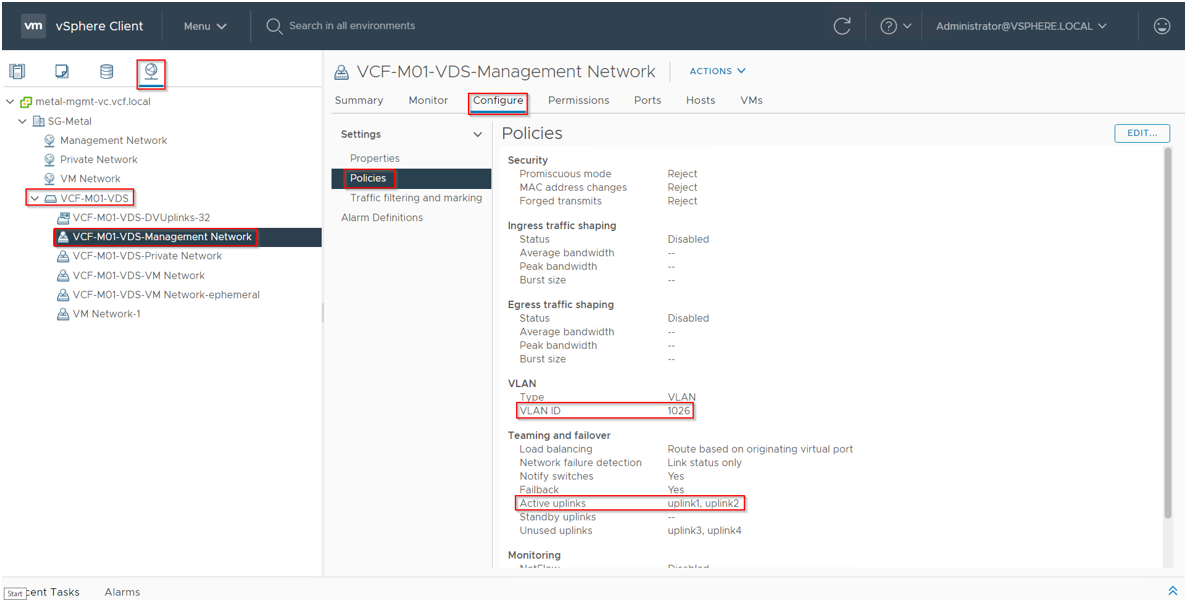
The active vCenter VM (VCSA) will be automatically moved to the new "ephemeral" port group within the vDS. If needed, you can modify the VCSA settings and adjust the vNIC network to the required Port Group.

vCenter is now fully operational on the newly configured distributed switch and port group.
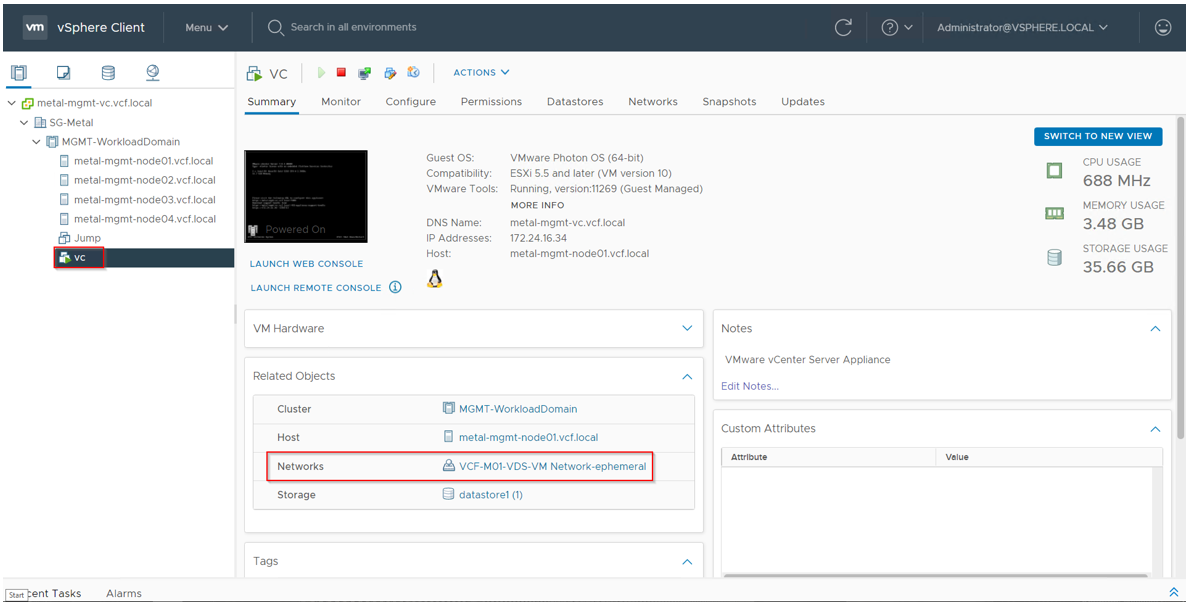
Conclusion
You've now deployed Metal servers with the VMware VCF Operating System Option on Equinix Metal.
You first deployed the servers through the Metal Portal. With the Layer 2 Unbonded trunk mode, VLANs were assigned to both eth0 and eth1 network interfaces. You accessed the servers through the out-of-band console, to assign custom private Management IPs and rotate ESXi passwords. You switched to VMware vCenter to create a Datacenter and Cluster, configure network settings, and add Virtual Distributed Switches. You used the Cluster QuickStart Wizard to establish distributed network switches and migrate VM workloads. You can now use VMware to control the servers running on your Layer 2 network, while maintaining the safety that a VLAN provides.
You may also like
Dig deeper into similar topics in our archives
Configuring BGP with BIRD 2 on Equinix Metal
Set up BGP on your Equinix Metal server using BIRD 2, including IP configuration, installation, and neighbor setup to ensure robust routing capabilities between your server and the Equinix M...

Configuring BGP with FRR on an Equinix Metal Server
Establish a robust BGP configuration on your Equinix Metal server using FRR, including setting up network interfaces, installing and configuring FRR software, and ensuring secure and efficie...

Crosscloud VPN with WireGuard
Learn to establish secure VPN connections across cloud environments using WireGuard, including detailed setups for site-to-site tunnels and VPN gateways with NAT on Equinix Metal, enhancing...

Deploy Your First Server
Learn the essentials of deploying your first server with Equinix Metal. Set up your project & SSH keys, provision a server and connect it to the internet.

Ready to kick the tires?
Use code DEPLOYNOW for $300 credit